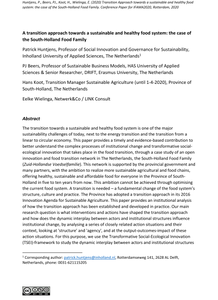The transition towards a sustainable and healthy food system is one of the major sustainability challenges of today, next to the energy transition and the transition from a linear to circular economy. This paper provides a timely and evidence-based contribution to better understand the complex processes of institutional change and transformative social-ecological innovation that takes place in the food transition, through a case study of an open innovation and food transition network in The Netherlands, the South-Holland Food Family (Zuid-Hollandse Voedselfamilie). This network is supported by the provincial government and many partners, with the ambition to realize more sustainable agricultural and food chains, offering healthy, sustainable and affordable food for everyone in the Province of South-Holland in five to ten years from now. This ambition cannot be achieved through optimising the current food system. A transition is needed – a fundamental change of the food system’s structure, culture and practice. The Province has adopted a transition approach in its 2016 Innovation Agenda for Sustainable Agriculture. This paper provides an institutional analysis of how the transition approach has been established and developed in practice. Our main research question is what interventions and actions have shaped the transition approach and how does the dynamic interplay between actors and institutional structures influence institutional change, by analysing a series of closely related action situations and their context, looking at 'structure' and 'agency', and at the output-outcomes-impact of these action situations. For this purpose, we use the Transformative Social-Ecological Innovation (TSEI)-framework to study the dynamic interplay between actors and institutional structures influencing institutional change. The example of TSEI-framework application in this paper shows when and how local agents change the institutional context itself, which provides relevant insights on institutional work and the mutually constitutive nature of structure and agency. Above institutional analysis also shows the pivotal role of a number of actors, such as network facilitators and provincial minister, and their capability and skills to combine formal and informal institutional environments and logics and mobilize resources, thereby legitimizing and supporting the change effort. The results are indicative of the importance of institutional structures as both facilitating (i.e., the province’s policies) and limiting (e.g. land ownership) transition dynamics.
DOCUMENT

Tijdens de HAS Food Experience 2021 voert Marjo Baeten gesprekken over het ontwerpen van duurzame voedselsystemen. In gesprek met de gasten komt aan bod wat hun visie op de uitdagingen in food vandaag de dag is én welke impactvolle, creatieve en ondernemende oplossingen er zijn bedacht zijn.
LINK
In light of the current debate on the impact of our current food system on climate changeand related mitigation strategies, addressing the acceptance of sustainability aspects within consumerbehavioral issues is of vital importance. However, the field remains mute on how those strategies canbe designed and employed effectively to stimulate sustainable food consumption behavior. Immersivenarrative design is a promising approach to engaging consumers in this context. Within this study, weshed light on how to create immersive, impactful, interactive narratives in augmented reality (AR)together with consumers. We propose a novel approach to how those stories can be planned, utilizingparticipatory design methods. Within a step-wise process, we develop the storyboard together withconsumers. In the next step, we evaluate multiple approaches with AR application developers onhow this storyline can be enhanced in AR considering the perspective of various stakeholders likedevelopers, behavioral scientists, and consumers. Finally, we propose a conceptual framework for howimmersive narratives can be designed and validated in a collaborative, multidimensional approachfor impactful AR narrative content designs to stimulate sustainable food behavior for consumers.
DOCUMENT

By transitioning from a fossil-based economy to a circular and bio-based economy, the industry has an opportunity to reduce its overall CO2 emission. Necessary conditions for effective and significant reductions of CO2-emissions are that effective processing routes are developed that make the available carbon in the renewable sources accessible at an acceptable price and in process chains that produce valuable products that may replace fossil based products. To match the growing industrial carbon demand with sufficient carbon sources, all available circular, and renewable feedstock sources must be considered. A major challenge for greening chemistry is to find suitable sustainable carbon that is not fossil (petroleum, natural gas, coal), but also does not compete with the food or feed demand. Therefore, in this proposal, we omit the use of first generation substrates such as sugary crops (sugar beets), or starch-containing biomasses (maize, cereals).
Aeres University of Applied Sciences has placed internationalisation as a key driver in its overall strategy. By prioritising the internationalisation of education and educational consultancy the university has created solid opportunities for students, lecturers, and partners at regional, national, and international levels. Currently, more strategic development on internationalisation in applied research at Aeres is needed. There is an opportunity to utilise highly proficient researchers, state-of-the-art facilities, and an impressive national research portfolio, and for this, there is a need to develop international research agenda, a key priority for AeresResearch4EU. To address this need, Aeres University of Applied Sciences aims to strengthen its internationalisation efforts with its research activities, opening the door to many opportunities, and most importantly, creating an international research agenda spanning the university's three locations. The main objectives of AeresResearch4EU are to analyse the existing research strategy and professorships and develop them towards a global research agenda for the European Union. By focusing on international research projects, Aeres can further enhance its reputation as a leading institution for applied research in agriculture, food, environment, and green technologies. AeresResearch4EU aims to create new partnerships and collaborations with researchers and institutions across Europe, allowing Aeres to contribute to developing innovative and sustainable solutions to global challenges. With its strong commitment to internationalisation and its focus on applied research, Aeres University of Applied Sciences is poised to become an essential player in the European research landscape.
Chemical preservation is an important process that prevents foods, personal care products, woods and household products, such as paints and coatings, from undesirable change or decomposition by microbial growth. To date, many different chemical preservatives are commercially available, but they are also associated with health threats and severe negative environmental impact. The demand for novel, safe, and green chemical preservatives is growing, and this process is further accelerated by the European Green Deal. It is expected that by the year of 2050 (or even as soon as 2035), all preservatives that do not meet the ‘safe-by-design’ and ‘biodegradability’ criteria are banned from production and use. To meet these European goals, there is a large need for the development of green, circular, and bio-degradable antimicrobial compounds that can serve as alternatives for the currently available biocidals/ preservatives. Anthocyanins, derived from fruits and flowers, meet these sustainability goals. Furthermore, preliminary research at the Hanze University of Applied Science has confirmed the antimicrobial efficacy of rose and tulip anthocyanin extracts against an array of microbial species. Therefore, these molecules have the potential to serve as novel, sustainable chemical preservatives. In the current project we develop a strategy consisting of fractionation and state-of-the-art characterization methods of individual anthocyanins and subsequent in vitro screening to identify anthocyanin-molecules with potent antimicrobial efficacy for application in paints, coatings and other products. To our knowledge this is the first attempt that combines in-depth chemical characterization of individual anthocyanins in relation to their antimicrobial efficacy. Once developed, this strategy will allow us to single out anthocyanin molecules with antimicrobial properties and give us insight in structure-activity relations of individual anthocyanins. Our approach is the first step towards the development of anthocyanin molecules as novel, circular and biodegradable non-toxic plant-based preservatives.
Lectoraat, onderdeel van HAS green academy

Lectoraat, onderdeel van NHL Stenden Hogeschool